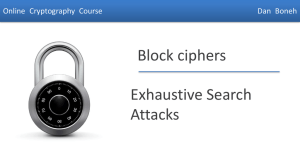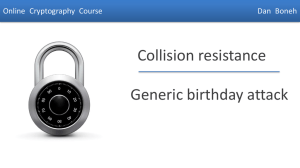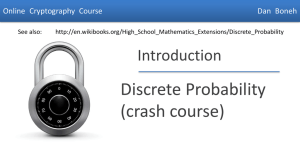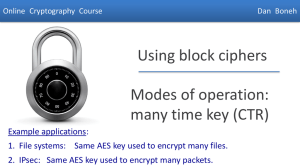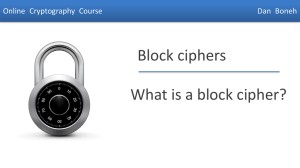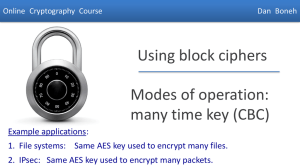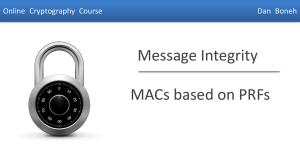Document
advertisement
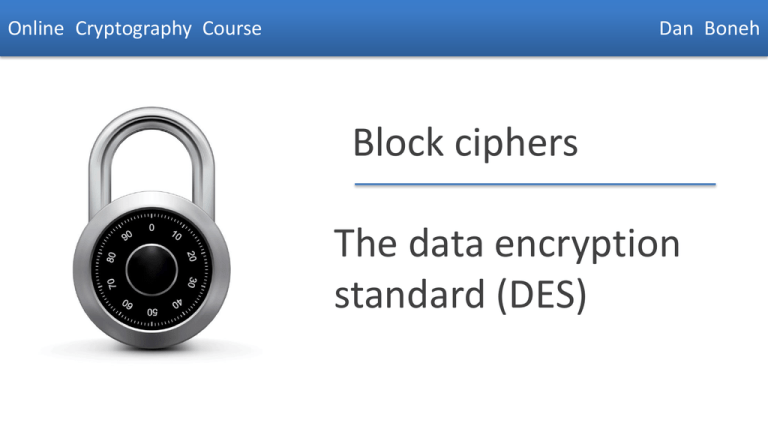
Online Cryptography Course
Dan Boneh
Block ciphers
The data encryption
standard (DES)
Dan Boneh
Block ciphers: crypto work horse
n bits
PT Block
n bits
CT Block
E, D
Key
k Bits
Canonical examples:
1. 3DES: n= 64 bits,
2. AES:
k = 168 bits
n=128 bits, k = 128, 192, 256 bits
Dan Boneh
Block Ciphers Built by Iteration
key k
k2
k3
kn
R(k2, )
R(k3, )
R(kn, )
m
k1
R(k1, )
key expansion
c
R(k,m) is called a round function
for 3DES (n=48),
for AES-128 (n=10)
Dan Boneh
The Data Encryption Standard (DES)
• Early 1970s: Horst Feistel designs Lucifer at IBM
key-len = 128 bits ; block-len = 128 bits
• 1973: NBS asks for block cipher proposals.
IBM submits variant of Lucifer.
• 1976: NBS adopts DES as a federal standard
key-len = 56 bits ; block-len = 64 bits
• 1997: DES broken by exhaustive search
• 2000: NIST adopts Rijndael as AES to replace DES
Widely deployed in banking (ACH) and commerce
Dan Boneh
DES: core idea – Feistel Network
Given functions f1, …, fd: {0,1}n ⟶ {0,1}n
Goal: build invertible function F: {0,1}2n ⟶ {0,1}2n
⊕
n-bits
L0
L1
f2
⊕
f1
R1
input
R2
L2
⋯
Rd-1
Rd
fd
Ld-1
⊕
n-bits
R0
Ld
output
In symbols:
Dan Boneh
R1
f1
L1
⊕
⊕
n-bits
L0
f2
R2
L2
input
⋯
Rd-1
Rd
fd
Ld-1
⊕
n-bits
R0
Ld
output
Claim: for all f1, …, fd: {0,1}n ⟶ {0,1}n
Feistel network F: {0,1}2n ⟶ {0,1}2n is invertible
Proof: construct inverse
Li-1
fi
⊕
Ri-1
Ri
Li
inverse
Ri-1 = Li
Li-1 = fi(Li) ⨁ Ri
Dan Boneh
R1
f1
L1
⊕
⊕
n-bits
L0
f2
R2
L2
⋯
Rd-1
Rd
fd
Ld-1
input
Ld
⊕
n-bits
R0
output
Claim: for all f1, …, fd: {0,1}n ⟶ {0,1}n
Feistel network F: {0,1}2n ⟶ {0,1}2n is invertible
Proof: construct inverse
Li-1
fi
⊕
Ri-1
Ri
Li
inverse
Ri
Li
⊕
fi
Ri-1
Li-1
Dan Boneh
Decryption circuit
n-bits
Rd
⊕
⊕
Rd-1
n-bits
fd
Ld
Rd-2
fd-1
Ld-1
Ld-2
⋯
R1
⊕
R0
f1
L1
L0
• Inversion is basically the same circuit,
with f1, …, fd applied in reverse order
• General method for building invertible functions (block ciphers)
from arbitrary functions.
• Used in many block ciphers … but not AES
Dan Boneh
“Thm:”
(Luby-Rackoff ‘85):
f: K × {0,1}n ⟶ {0,1}n a secure PRF
⇒ 3-round Feistel F: K3 × {0,1}2n ⟶ {0,1}2n a secure PRP
input
⊕
L0
L1
f
⊕
f
R1
R2
L2
f
⊕
R0
R3
L3
output
Dan Boneh
DES: 16 round Feistel network
f1, …, f16: {0,1}32 ⟶ {0,1}32
,
fi(x) = F( ki, x )
k
key expansion
input
IP
k2
⋯
k16
16 round
Feistel network
To invert, use keys in reverse order
IP-1
64 bits
64 bits
k1
output
Dan Boneh
The function F(ki, x)
S-box: function {0,1}6 ⟶ {0,1}4 , implemented as look-up table.
Dan Boneh
The S-boxes
Si: {0,1}6 ⟶ {0,1}4
Dan Boneh
Example: a bad S-box choice
Suppose:
Si(x1, x2, …, x6) = ( x2⨁x3, x1⨁x4⨁x5, x1⨁x6, x2⨁x3⨁x6 )
or written equivalently:
Si(x) = Ai⋅x (mod 2)
011000
100110
100001
011001
We say that Si is a linear function.
x1
. x2
x3
x4
x5
x6
=
x2⨁x3
x1⨁x4⨁x5
x1⨁x6
x2⨁x3⨁x6
Dan Boneh
Example: a bad S-box choice
Then entire DES cipher would be linear: ∃fixed binary matrix B s.t.
832
DES(k,m) =
64
m
. k1
k2
B
c
=
(mod 2)
⋮
k16
But then: DES(k,m1) ⨁ DES(k,m2) ⨁ DES(k,m3) = DES(k, m1⨁m2⨁m3)
B mk1 ⨁
B
m2
k
⨁
B m3
k
=
B
m1⨁m2⨁m3
k⨁k⨁k
Dan Boneh
Choosing the S-boxes and P-box
Choosing the S-boxes and P-box at random would result
in an insecure block cipher (key recovery after ≈224 outputs)
[BS’89]
Several rules used in choice of S and P boxes:
• No output bit should be close to a linear func. of the input bits
• S-boxes are 4-to-1 maps
⋮
Dan Boneh
End of Segment
Dan Boneh
